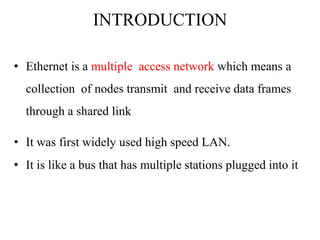Ethernet is a widely used local area network technology. It uses a bus topology with shared medium and uses CSMA/CD protocol for medium access. Ethernet frames have a minimum size of 64 bytes to allow for collision detection. Standard Ethernet implementations include 10Base5, 10Base2, 10Base-T and 10Base-F depending on the medium used. Bridges were introduced to increase bandwidth by dividing the network into collision domains while switches further improved performance by making the network full duplex.










































